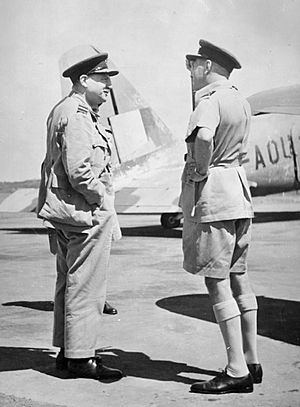Alan Lees facts for kids
Quick facts for kids
Sir Alan Lees
|
|
|---|---|

The new Air Officer Commanding No. 222 Group, Air Vice Marshal Lees (left), is greeted upon arrival at Ratmalana, Ceylon, by his predecessor Air Vice Marshal John D'Albiac, 1942.
|
|
| Born | 23 May 1895 Ashton-under-Lyne, Lancashire |
| Died | 14 August 1973 (aged 78) |
| Allegiance | United Kingdom |
| Service/ |
British Army (1914–18) Royal Air Force (1918–49) |
| Years of service | 1914–49 |
| Rank | Air Marshal |
| Commands held | Reserve Command (1946–49) No. 222 (General Reconnaissance) Group (1942–44) No. 2 Group (1941–42) RAF Driffield (1938–39) No. 1 (Indian Wing) Station (1932–37) No. 56 Squadron (1928–30) |
| Battles/wars | First World War Second World War |
| Awards | Knight Commander of the Order of the Bath Commander of the Order of the British Empire Distinguished Service Order Air Force Cross Mentioned in Despatches (5) Grand Officer of the Order of Orange-Nassau (Netherlands) |
Air Marshal Sir Alan Lees (born May 23, 1895 – died August 14, 1973) was a very important officer in the Royal Air Force (RAF). He rose through the ranks to become the Air Officer Commanding-in-Chief of the RAF Reserve Command. This means he was in charge of a large part of the RAF's reserve forces.
Contents
Sir Alan Lees' Military Journey
Sir Alan Lees started his military career during the First World War. He joined the British Army in 1914. He quickly became a pilot, which was a new and exciting role at the time.
Early Days as a Pilot
In 1915, Alan Lees became a pilot. He flew planes on the Western Front, which was a major battle area. In 1917, he was injured and captured by the enemy. This was a tough experience, but he survived.
Joining the Royal Air Force
After the First World War ended, a new military branch was created: the Royal Air Force. Alan Lees joined the RAF. This was a big step for him, moving from the army to the air force.
In 1928, he became the leader of No. 56 Squadron. This was an important flying unit. Later, in 1932, he was put in charge of No. 1 (Indian Wing) Station. This showed he was trusted with big responsibilities.
Leadership Before World War II
As the world moved closer to another war, Alan Lees continued to take on more leadership roles. In 1938, he became the Station Commander at RAF Driffield. This meant he was in charge of an entire air base.
In 1939, just as the Second World War was beginning, he joined the staff at the main office of RAF Bomber Command. This unit was responsible for planning bombing missions.
Roles During World War II
During the Second World War, Sir Alan Lees held several key positions. These roles were very important for the war effort.
- From 1941, he was the Air Officer Commanding No. 2 Group. This group played a big part in air operations.
- In 1942, he became the Air Officer Commanding No. 222 (General Reconnaissance) Group. This group focused on finding out what the enemy was doing.
- From 1944, he worked at the Headquarters of Air Command South East Asia. Here, he helped manage air operations in that region.
After the War
After the Second World War ended, Sir Alan Lees continued his service. He became the Air Officer Commanding-in-Chief of RAF Reserve Command. This role involved looking after the RAF's reserve forces. These are people who can be called upon if needed.
He retired from the RAF in 1949. During his time in the Reserve Command, he helped create a special tie and a trophy for members of the Air Training Corps. This group helps young people learn about aviation and the RAF.

